Spring has arrived exceptionally late at the Korea National Arboretum in Pocheon-si City, Gyeonggi-do Province.
Unlike more metropolitan areas which are already wrapping up their flower festivals this year, spring is just now finally reaching its peak at the arboretum, after being delayed by nearly a month.
Along the garden's Eco Road, a field of yellow forest poppies (Hylomecon vernalis) blooms for as far as the eye can see. Also called the summer or yellow forest poppy, these perennial plants can be found across the wetter areas of the mountains. In contrast to its beautiful yellow flower, the plant itself consists of a yellowish-red latex that looks like blood. Therefore, the Korean name for this plant is pinamul which literary means "blood herbs."

In the Ornamental Tree Garden, the cherry blossoms explode from the Manchurian cherry trees (Prunus mandshurica) and the Higan cherry trees (Prunus pendula), providing people with a visual feast. The Manchurian cherry in particular, a native to Korea, is known to bear fruit that has a particularly sharp taste. People in the past considered spring to have arrived when the flowers began to bloom on the Manchurian cherries and apricot trees.


Currently, there are 22 exhibition gardens at the Korea National Arboretum. Almost every type of tree and flower that can live on the peninsula can be found there.
Lee You-mi, director general of the Korea National Arboretum, said, "Unlike metropolitan areas, the peak of spring has finally hit here in Gwangneung. Many trees and plants that can be seen all across the peninsula can also be found here at the Korea National Arboretum. I hope you don't miss the chance to enjoy them all."
To visit the Korea National Arboretum, prior reservations must be made. Please visit the Korea National Arboretum's website (www.kna.go.kr) or go to the Korea National Arboretum's mobile reservation system (reservenew.kna.go.kr).
By Tae Sol
Korea.net Staff Writer
Photos: Korea National Arboretum
taesol@korea.kr
Unlike more metropolitan areas which are already wrapping up their flower festivals this year, spring is just now finally reaching its peak at the arboretum, after being delayed by nearly a month.
Along the garden's Eco Road, a field of yellow forest poppies (Hylomecon vernalis) blooms for as far as the eye can see. Also called the summer or yellow forest poppy, these perennial plants can be found across the wetter areas of the mountains. In contrast to its beautiful yellow flower, the plant itself consists of a yellowish-red latex that looks like blood. Therefore, the Korean name for this plant is pinamul which literary means "blood herbs."

Forest poppies' yellow flowers are in full bloom along the garden's Eco Road.
In the Ornamental Tree Garden, the cherry blossoms explode from the Manchurian cherry trees (Prunus mandshurica) and the Higan cherry trees (Prunus pendula), providing people with a visual feast. The Manchurian cherry in particular, a native to Korea, is known to bear fruit that has a particularly sharp taste. People in the past considered spring to have arrived when the flowers began to bloom on the Manchurian cherries and apricot trees.

Manchurian cherry trees adorn the Ornamental Tree Garden. The pink flowers show that spring in the arboretum is just about to begin.

Higan cherry trees can be found at every corner of the arboretum.
Currently, there are 22 exhibition gardens at the Korea National Arboretum. Almost every type of tree and flower that can live on the peninsula can be found there.
Lee You-mi, director general of the Korea National Arboretum, said, "Unlike metropolitan areas, the peak of spring has finally hit here in Gwangneung. Many trees and plants that can be seen all across the peninsula can also be found here at the Korea National Arboretum. I hope you don't miss the chance to enjoy them all."
To visit the Korea National Arboretum, prior reservations must be made. Please visit the Korea National Arboretum's website (www.kna.go.kr) or go to the Korea National Arboretum's mobile reservation system (reservenew.kna.go.kr).
By Tae Sol
Korea.net Staff Writer
Photos: Korea National Arboretum
taesol@korea.kr